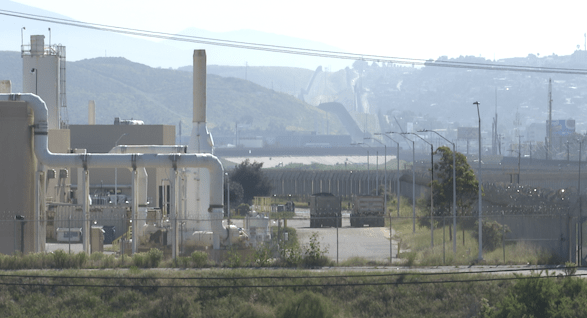SAN DIEGO (Border Report) — California Gov. Gavin Newsom spent Monday morning touring the Tijuana River Valley and the International Wastewater Treatment Plant in San Diego, and he also traveled south of the border to check out sewage mitigation projects in Baja California.
According to his office, Newsom was also briefed on the ongoing cross-border pollution impacting the region.
“The Tijuana River sewage crisis has impacted our communities for far too long,” Newsom said. “Thanks to our partnership with international, federal, and local partners, we are making real progress. But our work is far from over — we need serious, continued action to protect public health and restore our environment.”
On Tuesday, the governor and other state, federal and local officials are expected to attend a groundbreaking ceremony for the South Bay International Wastewater Treatment Plant, which will be renovated after years of neglect and decay.
“I think it’s important for the governor to be down here,” said Paloma Aguirre, the mayor of Imperial Beach, which has been widely affected by sewage and other pollution that, for decades, has come into the Tijuana River Valley from Mexico.
She’s relieved the plant will be refurbished but wants the state to address other needs and dangers that the pollution poses.
Tijuana River Valley residents urged to take survey on effects of sewage, pollution
The water treatment plant has “been in a state of disrepair for many years exasperated by the rains from last year and this year,” she said. “I think it’s important for him to see the condition of this plant, but most importantly, what I would urge the governor to do is just not just look at the plant because they’re so stuck and focused on the plant. The plant is not going to reduce our crisis, it’s only going to reduce the effluent that goes offshore.”
Aguirre says Newsom should focus on declaring a state of emergency clearing the way for more funding and less red tape to build other needed projects such as diverting the Tijuana River.
“A state of emergency would not only allow environmental laws to be waved, it would expedite the design in the diversion and treatment of the river, but would also put somebody in charge to oversee the public health crisis that is happening here and now.”
Aguirre says a state of emergency would also pave the way for health programs to treat people who are coming down with illnesses related to the sewage and pathogens that originate from it.
Sewage from Mexico affects recreational opportunities north of the border
“We’re having hundreds if not thousands of families over the years impacted, and now in the last two years, it’s gone up significantly by the toxic gases, pathogens that are being aerosolized by what’s coming through the river, which is why we continue to ask for a state of emergency,” Aguirre said. “This has nothing to do with the plant, we can take the river, divert it and treat it because we cannot be subject to Mexico, we need to armor our side with infrastructure that would allow us zero cross-border flow and anybody who says that’s not doable, that’s all excuses.”
Other local leaders like San Diego County Board of Supervisors Chair Nora Vargas, also see the river and its pollution as a detriment to public health.
“Pollution in the Tijuana River Valley is the number one environmental health crisis impacting our region, and Gov. Newsom coming to San Diego for today’s briefing shows his steadfast commitment to our communities,” Vargas said. “I have said time and again that the only way we will solve this crisis is by working together. Our collaboration with Gov. Newsom, as well as our federal partners, is critically important. We’re working to put forward our best collective efforts to restore and protect our region.”
Newsom also met with Baja California’s governor to discuss ongoing sewage and environmental issues affecting residents on both sides of the border.

